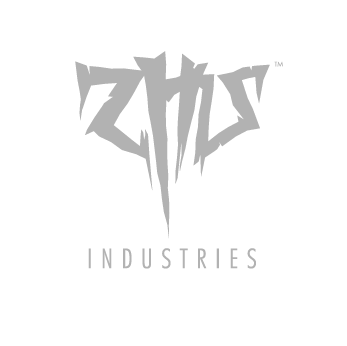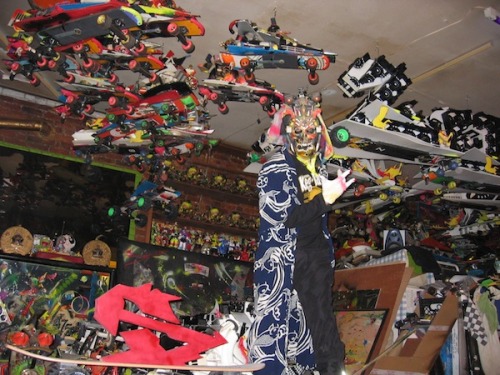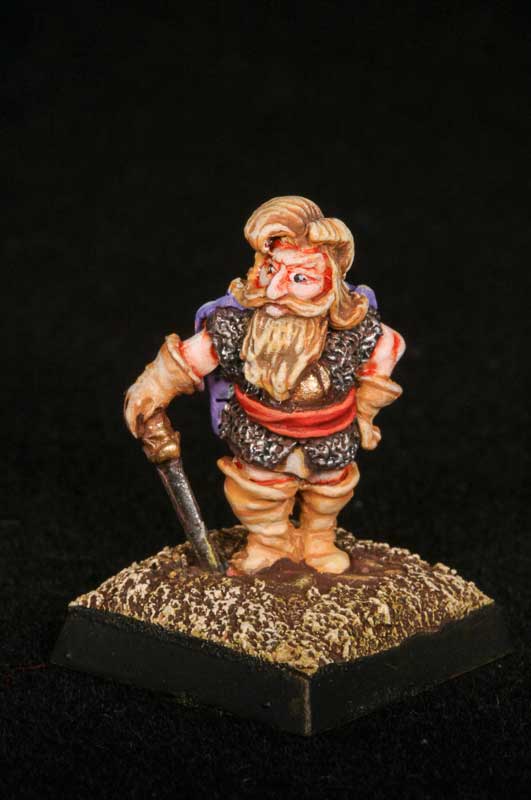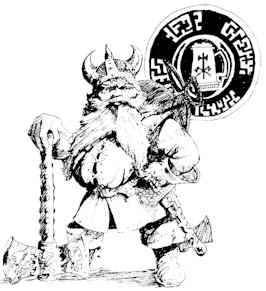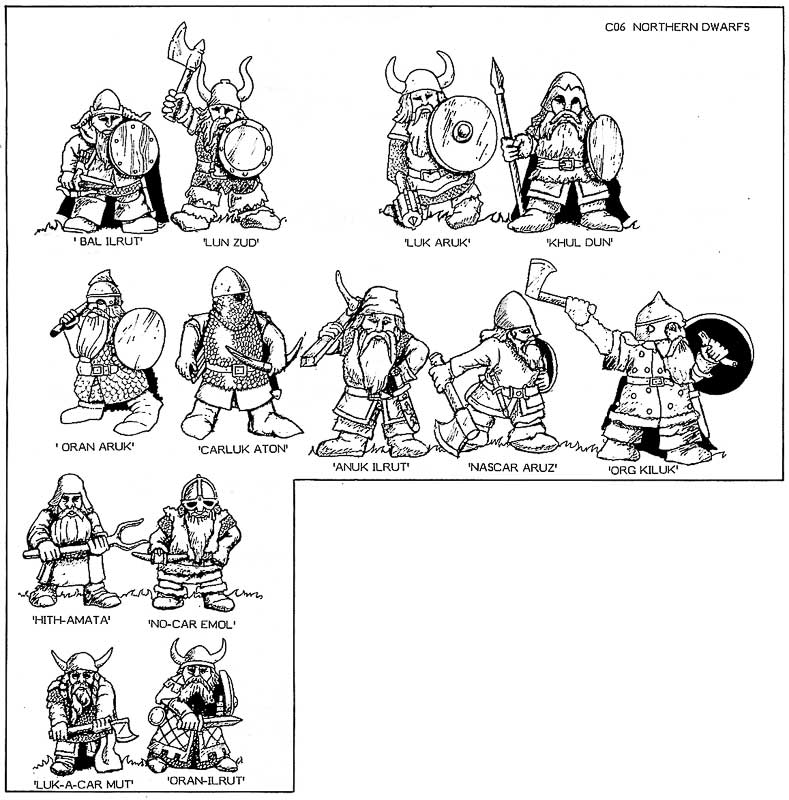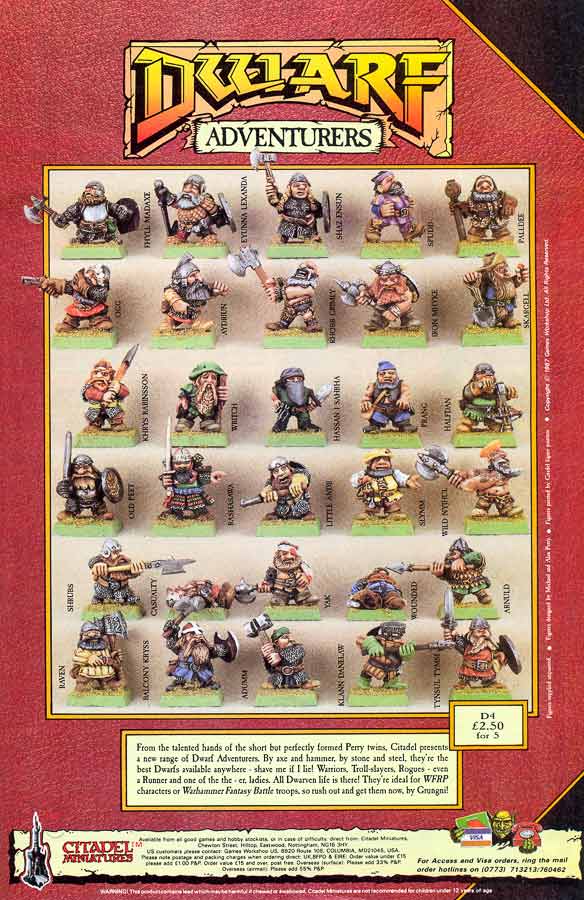The amazing Mr Mud
-
Hey all, quick one today, I just had this guy on the desk for ages and for
some reason I can't recall, it just moved up the painting queue. I've never ...
Sunday 3 December 2017
The Greatest Battle Report of 2017
As we're coming to the close of the year, I thought it might be fun to look back at some of the great batreps that people have been doing throughout 2017, perhaps bring some attention to some hidden gems and shine a light on the massive tabletop creativity that abounds in the old school scene.
This works something like this:
1. Nominate a great battle-report.
1.1 Must be relevant to Oldhammer in some way, be it old-school rules, miniatures or whathaveyou.
1.2 Must be published (not necessarily played) this year - 2017.
1.3 Must be publicly accessible on a blog or a forum or wherever for people to look at.
1.4 It can be your own, someone else's.
1.5 Just add a link to this thread on the Oldhammer forum, by 20th December 2017.
2. Vote for the best - I'll compile a poll of all the nominations around 21st of December
3. Win the winner then has the honour of sticking the 'the Greatest Battlereport 2017' graphic on their blog or just basking in the glory of well earned adoration.
Let the well documented, entertainingly written and presented battle commence!
http://forum.oldhammer.org.uk/viewtopic.php?f=6&t=13799
Monday 13 November 2017
Monster Man Comp: The Hex Beetle for AD&D
James Holloway over at the Gonzo History: Gaming Edition blog is having a monster design competition. The hook is, like Gary Gygax of old, you have to base the monster on a cheap toy. Sounds fun, so here's my quick and dirty entry, the Hex Beetle for Advanced Dungeons and Dragons:
No Appearing: 1-6
Armour Class: 1
Move: 12"
Hit Dice: 4
% in Lair: Nil
Treasure Type: See below
No. Of Attacks: 2
Damage/Attack: 1-12, plus 1-8 (zap)
Special Attacks: Nil
Special Defences: Phase (see below)
Magic Resistance: Standard
Intelligence; Low
Alignment: Neutral
Size: M(8')
The Hex Beetle is a 12-legged armour encased, insectoid crystaline life form that spends most of its time asleep on the ethereal plane. When the Hex Beetles dull senses detect a magic item in the vicinity o its equivalent position in the prime material plane, it awakens, enters the physical plane and attempts to sniff out and consume the magical device, however it has little sense of direction, and will scurry around bumping into things senselessly until it finds its quarry. The Hex Beetle must remain on the prime material plane in order to consume a magical item, which may take 1-6 turns.
If attacked whilst physical, the Hex Beetle will attempt to phase to an ethereal state (75% chance), which will stop its feeding. When out of phase they are impervious to nearly all forms of attack, although a phase door spell will cause one to remain in phase for 12 melee rounds. They are not particularly intelligent and will phase back to the material plane and attempt to locate the item and continue feeding in 1-2 turns, even if the threat has not passed.
If successfully defeated, the crystal innards will shatter leaving 1-12 randomly determined gems (DMG P.25), plus one gem of the same type which is the ‘brain’ of the creature. This possesses the properties of a Gem of Seeing (DMG P.145) and will detect as magical. The metal casing appears mundane, but will also detect as magical, each Hex Beetle corpse supplies approximately 1/3rd the amount of metal required to create a suit of Plate Mail of Etherealness (DMG P.164). There is a 50% chance of these items being cursed.
The Hex Beetle is somewhat biddable, and if promised magical items to consume may carry out simple tasks, but will not attack others unless it carries a magical item for the Hex Beetle to feed on.
James has contracted an impressive list of sponsors and prizes, for the competition, including many familiar names, such as Chaotic Henchmen Productions , Oakbound Studios, Otherworld Miniatures and Grant Howitt . The full rules of the competition are here - it doesn't have to be AD&D, I considered writing up the Hex Bug: Nano for Cyberpunk 2013 (Scavenger Bot), Empire of the Petal Thrones (The Interminable Devourer of Eyes!), and Warhammer 40k: Rogue Trader (Insectoid Warp Beast) before settling on AD&D, and Hexbugs aren't really cheap either, so I might have disqualified myself there...
Well worth entering, not just for the chance to win cool prizes, but the fun of transforming a toy into a gaming thing. The competition deadline is Sunday, 26 November so still plenty of time to dive into the toy box and write up something!
http://gonzohistorygaming.blogspot.co.uk/2017/11/the-first-monster-man-contest.html
 |
| Hex Beetle |
Beetle, Hex
Frequency: Very RareNo Appearing: 1-6
Armour Class: 1
Move: 12"
Hit Dice: 4
% in Lair: Nil
Treasure Type: See below
No. Of Attacks: 2
Damage/Attack: 1-12, plus 1-8 (zap)
Special Attacks: Nil
Special Defences: Phase (see below)
Magic Resistance: Standard
Intelligence; Low
Alignment: Neutral
Size: M(8')
The Hex Beetle is a 12-legged armour encased, insectoid crystaline life form that spends most of its time asleep on the ethereal plane. When the Hex Beetles dull senses detect a magic item in the vicinity o its equivalent position in the prime material plane, it awakens, enters the physical plane and attempts to sniff out and consume the magical device, however it has little sense of direction, and will scurry around bumping into things senselessly until it finds its quarry. The Hex Beetle must remain on the prime material plane in order to consume a magical item, which may take 1-6 turns.
If attacked whilst physical, the Hex Beetle will attempt to phase to an ethereal state (75% chance), which will stop its feeding. When out of phase they are impervious to nearly all forms of attack, although a phase door spell will cause one to remain in phase for 12 melee rounds. They are not particularly intelligent and will phase back to the material plane and attempt to locate the item and continue feeding in 1-2 turns, even if the threat has not passed.
If successfully defeated, the crystal innards will shatter leaving 1-12 randomly determined gems (DMG P.25), plus one gem of the same type which is the ‘brain’ of the creature. This possesses the properties of a Gem of Seeing (DMG P.145) and will detect as magical. The metal casing appears mundane, but will also detect as magical, each Hex Beetle corpse supplies approximately 1/3rd the amount of metal required to create a suit of Plate Mail of Etherealness (DMG P.164). There is a 50% chance of these items being cursed.
The Hex Beetle is somewhat biddable, and if promised magical items to consume may carry out simple tasks, but will not attack others unless it carries a magical item for the Hex Beetle to feed on.
James has contracted an impressive list of sponsors and prizes, for the competition, including many familiar names, such as Chaotic Henchmen Productions , Oakbound Studios, Otherworld Miniatures and Grant Howitt . The full rules of the competition are here - it doesn't have to be AD&D, I considered writing up the Hex Bug: Nano for Cyberpunk 2013 (Scavenger Bot), Empire of the Petal Thrones (The Interminable Devourer of Eyes!), and Warhammer 40k: Rogue Trader (Insectoid Warp Beast) before settling on AD&D, and Hexbugs aren't really cheap either, so I might have disqualified myself there...
Well worth entering, not just for the chance to win cool prizes, but the fun of transforming a toy into a gaming thing. The competition deadline is Sunday, 26 November so still plenty of time to dive into the toy box and write up something!
http://gonzohistorygaming.blogspot.co.uk/2017/11/the-first-monster-man-contest.html
Monday 6 November 2017
Gothic Futurism
RAMM:ΣLL:ZΣΣ or, Rammellzee is a hip hop legend legend. Born 1960, passed 2010. Graffiti writer, rapper, sculptor, art theorist, junk-bot modeller and the originator of the philosophy and practice of the Ikonoklast Panzerism within a broader philosophy he developed in the late 1970s called Gothic Futurism.
The essence of Rammellzee's manifesto is that language is an act of violence, and by deconstructing its symbols and refactoring them into wildstyle science-fiction graffiti space-ship designs and junkbot racecars, they can be liberated from the tyranny of language. Once liberated, they can then be weaponised against further manipulation through the style he defines as Ikonoklast Panzerism. Thus simultaneously dismantling and elucidating the physical language as embodying a culture and history of violence. It is a similar linguistic battleground occupied by William S. Burroughs and Genesis Breyer P-Orridge, but informed by the history of typography. You can read Ionic Treatsie Gothic Futurism from Rammellzee's archived website at archive.org.
Rammellzee makes reference to the letterforms of monastical calligraphy as the secret origin of Wildstyle graphiti writing, and proclaims the return to the hand-made, ornamental letter pushing at the boundaries of legibility as a reclaiming of the linguistic shapes against the mechanical tyranny of Gutenburgs press and its digital descendants. If we look at the typeface categories above (notably missing the egyptian / slab-serif) it's clear that Blackletter is a substantially different shape. Rammellzee sees the additional strokes, the sharp curves, hooks and pointed finials as a form of weaponisation, not only visually spiky but rendering them illegible. Taking this a step further, Ikonoklast Panzerizm transforms letters into designs for speed-racer warships, the ultimate weaponized graphemes of the ideological rap-battles and oppression of the masses by the tyranny of language is at once a simultaneous return to the sacred practices of the monastic orders, as well as a leaping forward into an anarchic vision of the future.
“Humans...in the 14th Century the monks ornamented and illustrated the manuscripts of letters. In the 21st and 22nd century the letters of the alphabet through competition are now armamented for letter racing and galactic battles. This was made possible by a secret equation known as THE RAMM:ELL:ZEE."
Rammellzee remains something of an outsider figure, his theories considered 'out-there', embedded as it is in the somewhat obscure grounds of typographical history, semantic theory and science fiction. While posthumously his paintings (knotted minds) have recently fetched over $40,000 at auction, and have been the subject of major exhibitions, there is still no published monograph, instead we have to rely on fragmentary documentation to piece together an understanding of his body of work, and perhaps this complexity is appropriate.
B▲††:LΣF:LΣΣT // GO†HIC VS. GO†HIC FV†VRISM
The ideology of Gothic Futurism and the techniques of Ikonic Panzerism lend themselves as a critical lens through which to perceive other works - it is something to think with. This is somewhat fraught, Ramillezzes body of work and theoretical expression stand alone as a testament to the mans genius, and as this 1999 interview on 88 Hip Hop indicates he clearly lived within the conceptual framework, but as the Cult of Rammillezz admirably demonstrate, the legacy of his work and theory lives on, expanding boundaries and . Frequent readers of this blog won't be surprised at all to find a suitable target for this critical assault in the universe of Warhammer 40,000.
There are a number of vectors, one is that Rammelzee was actively involved in the design of science-fiction or fantastical characters and vehicles, so the there are parallels in the subject matter. There are material parallels in technique (at least in early Rogue Trader) in the construction of model vehicles specifically out of junk. And finally, there are concepts we can associate under a broader philosophy of Gothic Futurism, the theme of militarisation of historical forms in a science fiction context, all of which make WH40K seem appropriate.
 |
| Rammellzee | Ikonoklast |
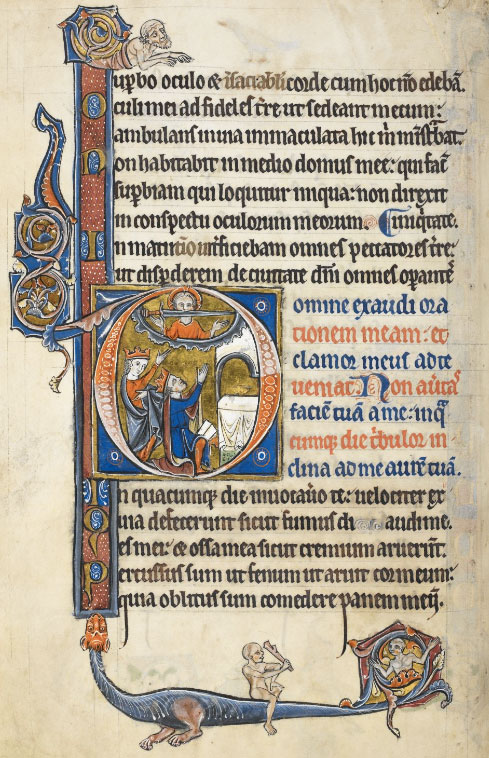 |
| Blackletter calligraphy |
 |
| Blackletter typeface |
 |
| COPE2 | Wildstyle |
 |
| Typeface Categories | via |
Rammellzee makes reference to the letterforms of monastical calligraphy as the secret origin of Wildstyle graphiti writing, and proclaims the return to the hand-made, ornamental letter pushing at the boundaries of legibility as a reclaiming of the linguistic shapes against the mechanical tyranny of Gutenburgs press and its digital descendants. If we look at the typeface categories above (notably missing the egyptian / slab-serif) it's clear that Blackletter is a substantially different shape. Rammellzee sees the additional strokes, the sharp curves, hooks and pointed finials as a form of weaponisation, not only visually spiky but rendering them illegible. Taking this a step further, Ikonoklast Panzerizm transforms letters into designs for speed-racer warships, the ultimate weaponized graphemes of the ideological rap-battles and oppression of the masses by the tyranny of language is at once a simultaneous return to the sacred practices of the monastic orders, as well as a leaping forward into an anarchic vision of the future.
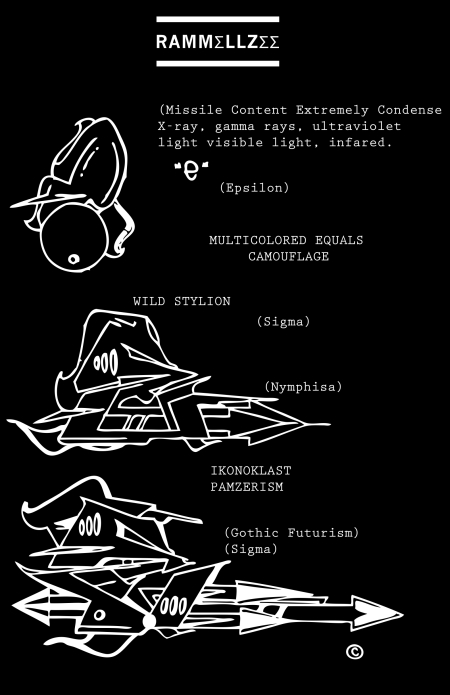 |
| Ikonoklast Panzerism | Gothic Futurism |
“Humans...in the 14th Century the monks ornamented and illustrated the manuscripts of letters. In the 21st and 22nd century the letters of the alphabet through competition are now armamented for letter racing and galactic battles. This was made possible by a secret equation known as THE RAMM:ELL:ZEE."
| Starbased Extendor (Militarily the Unreadable) |
The New York graffiti artist and B-boy theoretician Rammellzee
constitutes yet another incarnation of Afrofuturism. Greg Tate holds
that Rammellzee’s “formulations on the juncture between black and
Western sign systems make the extrapolations of [Houston] Baker and
[Henry Louis] Gates seem elementary by comparison.” As evidence, he
submits the artist’s “Ikonoklast Panzerism,” a heavily armored
descendant of late ’70s “wild style” graffiti (those bulbous letters
that look as if they were twisted out of balloons). A 1979 drawing
depicts a Panzerized letter “S”: it is a jumble of sharp angles that
suggests the Nude Descending a Staircase bestriding a Jet Ski.
“The Romans stole the alphabeta system from the Greeks through war,” explains Rammellzee. “Then, in medieval times, monks ornamented letters to hide their meaning from the people. Now, the letter is armored against further manipulation.”
Whilst the majority of Rammellzee's graffiti is inspired by linguistics, semiotics and the history of language and the history of typography, Rammellzees work also embraced character design, through costuming and toy-cutting, as well as model-making out of junk and found objects based on his graffiti designs, building an entire pop-culture science-fiction inflected universe.
Rammellzee’s Afrofuturist appropriation of the castoff oddments of
technoculture is semiotic guerrilla warfare, just as his “slanguage”—a
heavily encrypted hip-hop argot—is the linguistic equivalent of graffiti
“tags” all over the mother tongue. In an essay on English as the
imperial language of the Internet, the cultural critic McKenzie Wark
argues for the willful, viral corruption of the lingua franca of global
corporate monoculture as a political act.
Some critics situate the work within the context of Afro-futurism, the cultural nexus of science fiction of African decent, but to my mind Rammellzee transcends ethnogenre, the combination of oriental exoticism - Japanese samurai and mecha imagery, African mask making traditions, medieval European monastical calligraphy and the development of western typography, ancient Greek language, bespokes an eclectic, universalist, globalised awareness that isn't specifically focused on African or Afro-American cultural experiences.
Denying Rammellzee his blackness would be stupid, his engagement and the origin of his work in 'urban street culture' of New York, his ethnic roots as a man of African decent are strong influences in his work. So perhaps are the transformative semiotics of Sun Ra's deconstruction of the spoken work, as Rammellzee uncovers the abstract 'military function' of the symbolism of the alphabet. Where Ra is an angel from Saturn sent to take Black people into space, Rammellzee is a 10th Century assasin-monk liberating language from humanity. Definitions of Afro-futurism often set their horizons too specifically to fully embrace Rammellzee, have a smaller landscape which would encircle Rammellzee's culturally transgressive theories and practices, the near universal applicability of his art-theory and an essentially multicultural / fusion-futurism that is readily understood in his work due to his appropriation of wide sources.
“The Romans stole the alphabeta system from the Greeks through war,” explains Rammellzee. “Then, in medieval times, monks ornamented letters to hide their meaning from the people. Now, the letter is armored against further manipulation.”
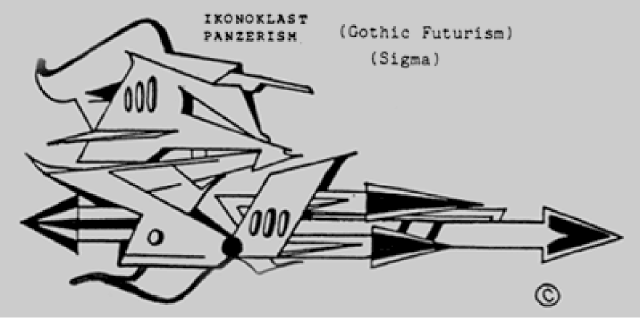 | |
| IKONOKLAST PANZERISM: GOTHIC FUTURISM (sigma) RAMM:ΣLL:ZΣΣ |
Whilst the majority of Rammellzee's graffiti is inspired by linguistics, semiotics and the history of language and the history of typography, Rammellzees work also embraced character design, through costuming and toy-cutting, as well as model-making out of junk and found objects based on his graffiti designs, building an entire pop-culture science-fiction inflected universe.
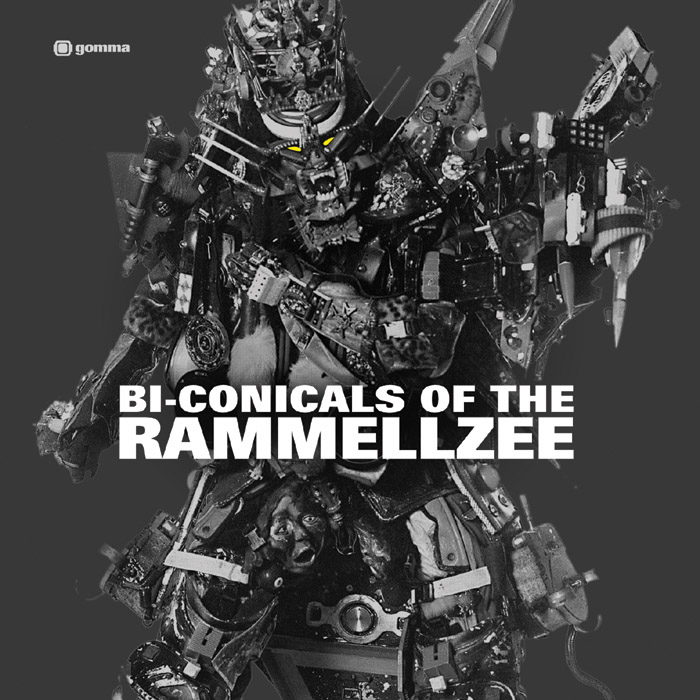 |
| RAMM:ΣLL:ZΣΣ | robot costume | album cover |
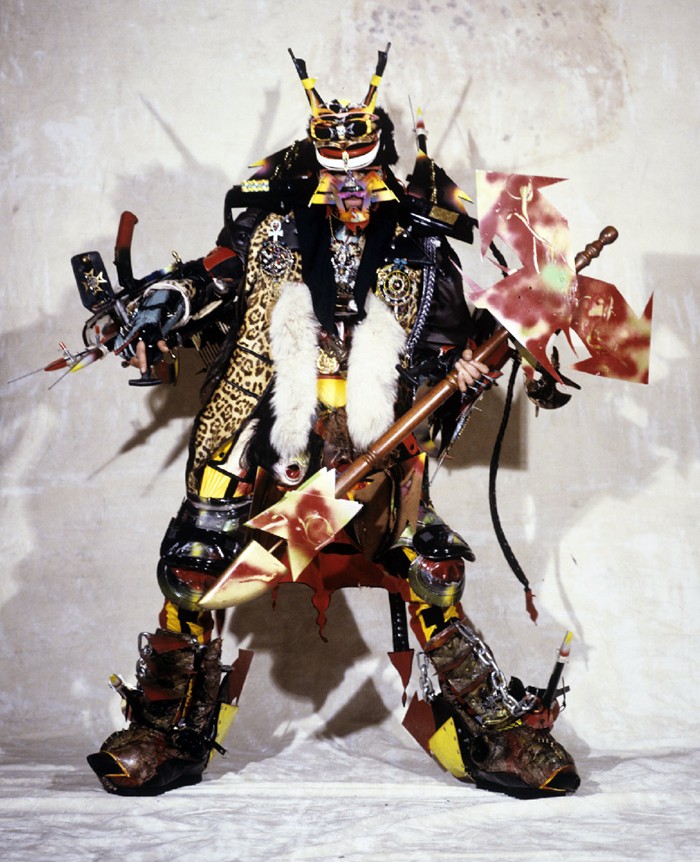 |
| RAMM:ΣLL:ZΣΣ costume |
 |
| Rammellzee | custom action figures |
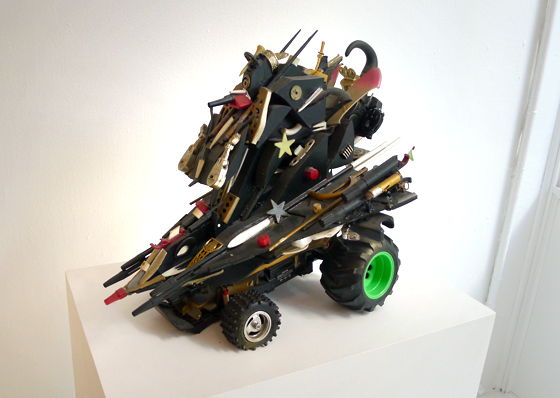 |
| Rammellzee | Letter Racer | via |
- Mark Dery “Black to the Future” Flame Wars (November 1994) (via deeptime.net)
Some critics situate the work within the context of Afro-futurism, the cultural nexus of science fiction of African decent, but to my mind Rammellzee transcends ethnogenre, the combination of oriental exoticism - Japanese samurai and mecha imagery, African mask making traditions, medieval European monastical calligraphy and the development of western typography, ancient Greek language, bespokes an eclectic, universalist, globalised awareness that isn't specifically focused on African or Afro-American cultural experiences.
Denying Rammellzee his blackness would be stupid, his engagement and the origin of his work in 'urban street culture' of New York, his ethnic roots as a man of African decent are strong influences in his work. So perhaps are the transformative semiotics of Sun Ra's deconstruction of the spoken work, as Rammellzee uncovers the abstract 'military function' of the symbolism of the alphabet. Where Ra is an angel from Saturn sent to take Black people into space, Rammellzee is a 10th Century assasin-monk liberating language from humanity. Definitions of Afro-futurism often set their horizons too specifically to fully embrace Rammellzee, have a smaller landscape which would encircle Rammellzee's culturally transgressive theories and practices, the near universal applicability of his art-theory and an essentially multicultural / fusion-futurism that is readily understood in his work due to his appropriation of wide sources.
Rammellzee remains something of an outsider figure, his theories considered 'out-there', embedded as it is in the somewhat obscure grounds of typographical history, semantic theory and science fiction. While posthumously his paintings (knotted minds) have recently fetched over $40,000 at auction, and have been the subject of major exhibitions, there is still no published monograph, instead we have to rely on fragmentary documentation to piece together an understanding of his body of work, and perhaps this complexity is appropriate.
B▲††:LΣF:LΣΣT // GO†HIC VS. GO†HIC FV†VRISM
The ideology of Gothic Futurism and the techniques of Ikonic Panzerism lend themselves as a critical lens through which to perceive other works - it is something to think with. This is somewhat fraught, Ramillezzes body of work and theoretical expression stand alone as a testament to the mans genius, and as this 1999 interview on 88 Hip Hop indicates he clearly lived within the conceptual framework, but as the Cult of Rammillezz admirably demonstrate, the legacy of his work and theory lives on, expanding boundaries and . Frequent readers of this blog won't be surprised at all to find a suitable target for this critical assault in the universe of Warhammer 40,000.
There are a number of vectors, one is that Rammelzee was actively involved in the design of science-fiction or fantastical characters and vehicles, so the there are parallels in the subject matter. There are material parallels in technique (at least in early Rogue Trader) in the construction of model vehicles specifically out of junk. And finally, there are concepts we can associate under a broader philosophy of Gothic Futurism, the theme of militarisation of historical forms in a science fiction context, all of which make WH40K seem appropriate.
| RAMM:ΣLL:ZΣΣ | GOTHIC FUTURISM (sigma) 1979 |
 | |
|
On a purely formal level the similarities between the design for the Emperor Class Battleship spacecraft from Games Workshops Battlefleet Gothic (1999 - based on designs originally in Space Fleet 1991) and Rammellzee's Gothic Futurist Sigma are clear. The scooped prow, the over-all length and proportion, the raised turret at the back. But where Rammellzee has distorted, transformed and weaponized the greek letter Σ (still evident but barely recognisable) to evoke speed, movement and warfare. Games Workshop has mutated Gothic, cathedral architecture in more or less the same conceptual, if not stylistic direction.
Re imagining the visual graphology of monastical orders - in the equation-space of
Ikonoklast Panzerism the visual spectacle of scribal calligraphy as weaponised, mobile, galactic craft, typography as weapon.
In the equation-space of Battlefleet Gothic, the architecture of the Medieval Cathedral becomes a weaponised, mobile, galactic craft, architecture as weapon.
No longer the spatial, built environment in which violence physically occurs, "The Building" becomes a symbolic representation of an ideological concept - "The Empire" and its vector of aggression "The Battleship". In Terry Gilliams The Crimson Permanent Assurance the architectural forms of a London office block are set loose from their moorings and transformed into a battleship, filing cabinets as cannons, scaffold sheeting as sails, immobile architecture made dynamic and aggressive.
In the Imperial fleet of Battlefleet Gothic flying buttress or arched window no longer required for stones to overcome gravity and hold a structure in place, but required only to communicate an idea of baroque and archaic religiosity, liberated from their engineering function into the realm of the purely expressive, a sign for monasticism. The rest of the game-world follows suit, be it Imperial Kultus, Eldar Craftworld, Ork Waaagh or beast-craft of the Tyranid Hive Mind, each faction is visually defined by a formalised stylistic langue, and by a process of Iconoclast Panzerism each is, in turn freed from its original function (be it biological, craft, religious) and transformed into an object of symbolic weaponisation.
Battlefleet Gothic, in its deep-space reference in turn raises questions about non-fictional historical architecture and spacecraft design not as a necessary response to the demands of space, materials, human interaction, engineering and craft, but as a primarily linguistic and communicative act of cultural identity formation - the langue of a faction - as physical manifestations of ideological propaganda.
The engineers of The Space Race - NASA and the USSR working on little more than Cold War propaganda machines, throwing hugely expensive phallic symbols into the sky as declarations of their earthly dominance, solidifying national identity and cultural commitment to nebulously practical modernist, rational, scientific progress - what have the moon landings ever done for us? their value, like most 'big science' tends to be primarily a grandiose public relations stunt, a technically fetishistic fireworks display for a culture drunk on spectacle.
In terms of historical architecture and especially the medieval, there are numerous examples of imposition of ecclesiastical buildings on old pagan sites occurring throughout Europe (and the Holy Land). It does not take a huge leap of imagination to think of these buildings, chapels and Cathedrals in full stone clad gothic regalia as material and symbolic breach points, enclaves of control of a war of faith waged upon the native pagans and newly converted christians, much as the Imperial Kultus in Battlefleet Gothic attempts to dominate space within the game. This dividing and controlling of space, as a commander in a wargame, a player in chess or the captain of a football team controls the field of battle by placing their pieces strategically to cover the significant ground.
In folklore the ominous sound of the bells of church towers not only call the faithful to prayer but also drive away the native trolls from the area - such tales rely heavily on the symbolic nature of architecture and is part and parcel of why Black Metal bands burned churches in the 1990s, and speaks to the placement of Roman Triumphal arches and other examples of understanding architecture primarily as expressions of imperialist intent.
Architecture thus can be seen as having a long history as tool of oppression and control by the conquering peoples, the ruling elites. Much as Ikonoklast Panzerism characterises typographys constraint to the conventional letterform as submission to a history of oppression, and the aesthetic weaponisation of letterforms as taking them beyond their linguistic function, architectures dominance of the human environment is too disrupted by graffiti. The uniformity of the built environment challenged by the individual, its oppressive continuum as an organising principle reconfigured.
Addendum: it is not only architecture that is transformed in this way, New York graffiti scene, and RAMMELZEE specifically, sprang up writing on trains - that is the transport infrastructure of the city, historically the Roman road as the arteries of imperialism, and reconnecting with the Cold War space race as vehicular expressions of power.
To walk through the urban environment with the eye and mind of a graffiti writer is dismantle the intended organisation of space, the town planners drawings are sliced up and reconfigured into an entirely new landscape. The ignored undersides of bridges become focal points, boundaries become access points, the landscape becomes a map of vantage-points where grafitti may be seen and concealments where a writer may be undisturbed. Opportunities for expression open up within ignored, abandoned and liminal spaces. The tags, throwups and pieces left behind by other writers become markers, not only a patina that indicates safe-spaces for illicit writing, but a dynamic system of rivalry and community that weaves its way through the otherwise static canyons of urban space that in the dominant culture exist only as dead-space between land-banks, glass and concrete investment portfolios, the wreckage of broken machines for living in and zones of social control.
Central to this battleground of architecture vs. letterform is the idea of abandonment and reclamation. The substrate - the surface - upon which Ikonoklast Panzerism takes place - be it the A-train or a tenement block is an alien artefact, designed and created entirely outside the social sphere of those who inherit and occupy the space. Graffiti, and weaponised intergalactic graffiti at that, reclaims the impersonal, tyrannical object - the building - destroys it's authoritarian purpose and transforms it into an entirely new narrative.

 |
| Lewis Orr (1876-1966) \ Notre Dame \ |
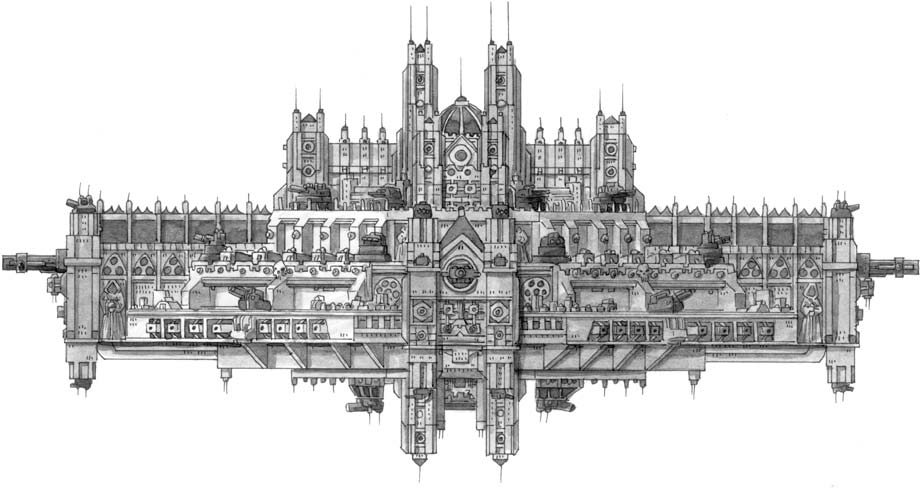 |
| Games Workshop / Ramilles Class Star Fort / BFG |
Re imagining the visual graphology of monastical orders - in the equation-space of
Ikonoklast Panzerism the visual spectacle of scribal calligraphy as weaponised, mobile, galactic craft, typography as weapon.
 |
| Ramileeze | via |
In the equation-space of Battlefleet Gothic, the architecture of the Medieval Cathedral becomes a weaponised, mobile, galactic craft, architecture as weapon.
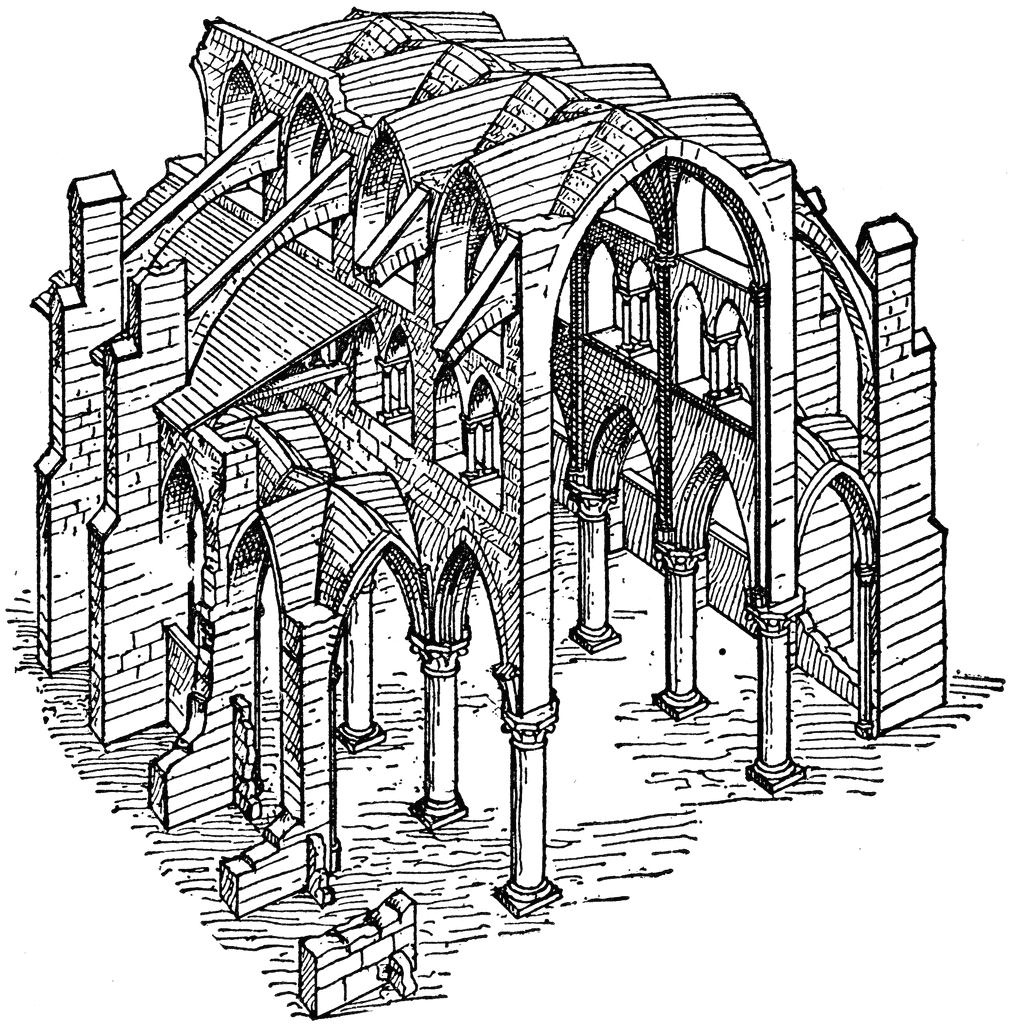 |
| weapon |
In the Imperial fleet of Battlefleet Gothic flying buttress or arched window no longer required for stones to overcome gravity and hold a structure in place, but required only to communicate an idea of baroque and archaic religiosity, liberated from their engineering function into the realm of the purely expressive, a sign for monasticism. The rest of the game-world follows suit, be it Imperial Kultus, Eldar Craftworld, Ork Waaagh or beast-craft of the Tyranid Hive Mind, each faction is visually defined by a formalised stylistic langue, and by a process of Iconoclast Panzerism each is, in turn freed from its original function (be it biological, craft, religious) and transformed into an object of symbolic weaponisation.
Battlefleet Gothic, in its deep-space reference in turn raises questions about non-fictional historical architecture and spacecraft design not as a necessary response to the demands of space, materials, human interaction, engineering and craft, but as a primarily linguistic and communicative act of cultural identity formation - the langue of a faction - as physical manifestations of ideological propaganda.
The engineers of The Space Race - NASA and the USSR working on little more than Cold War propaganda machines, throwing hugely expensive phallic symbols into the sky as declarations of their earthly dominance, solidifying national identity and cultural commitment to nebulously practical modernist, rational, scientific progress - what have the moon landings ever done for us? their value, like most 'big science' tends to be primarily a grandiose public relations stunt, a technically fetishistic fireworks display for a culture drunk on spectacle.
In terms of historical architecture and especially the medieval, there are numerous examples of imposition of ecclesiastical buildings on old pagan sites occurring throughout Europe (and the Holy Land). It does not take a huge leap of imagination to think of these buildings, chapels and Cathedrals in full stone clad gothic regalia as material and symbolic breach points, enclaves of control of a war of faith waged upon the native pagans and newly converted christians, much as the Imperial Kultus in Battlefleet Gothic attempts to dominate space within the game. This dividing and controlling of space, as a commander in a wargame, a player in chess or the captain of a football team controls the field of battle by placing their pieces strategically to cover the significant ground.
 |
| La Hougue Bie | Medieval church built on Neolithic grave |
In folklore the ominous sound of the bells of church towers not only call the faithful to prayer but also drive away the native trolls from the area - such tales rely heavily on the symbolic nature of architecture and is part and parcel of why Black Metal bands burned churches in the 1990s, and speaks to the placement of Roman Triumphal arches and other examples of understanding architecture primarily as expressions of imperialist intent.
 |
| Subway | Rammellzee |
Addendum: it is not only architecture that is transformed in this way, New York graffiti scene, and RAMMELZEE specifically, sprang up writing on trains - that is the transport infrastructure of the city, historically the Roman road as the arteries of imperialism, and reconnecting with the Cold War space race as vehicular expressions of power.
To walk through the urban environment with the eye and mind of a graffiti writer is dismantle the intended organisation of space, the town planners drawings are sliced up and reconfigured into an entirely new landscape. The ignored undersides of bridges become focal points, boundaries become access points, the landscape becomes a map of vantage-points where grafitti may be seen and concealments where a writer may be undisturbed. Opportunities for expression open up within ignored, abandoned and liminal spaces. The tags, throwups and pieces left behind by other writers become markers, not only a patina that indicates safe-spaces for illicit writing, but a dynamic system of rivalry and community that weaves its way through the otherwise static canyons of urban space that in the dominant culture exist only as dead-space between land-banks, glass and concrete investment portfolios, the wreckage of broken machines for living in and zones of social control.
Central to this battleground of architecture vs. letterform is the idea of abandonment and reclamation. The substrate - the surface - upon which Ikonoklast Panzerism takes place - be it the A-train or a tenement block is an alien artefact, designed and created entirely outside the social sphere of those who inherit and occupy the space. Graffiti, and weaponised intergalactic graffiti at that, reclaims the impersonal, tyrannical object - the building - destroys it's authoritarian purpose and transforms it into an entirely new narrative.

These creative strategies, formulated by the equation RAMM:ΣLL:ZΣΣ and expressed through the ideology of Gothic Futurism and the strategy of Ikonoklast Panzerism and the tactical deployment through graffiti letterforms, modelling, story telling and character design, leave a vibrant and unique body of work. The parallels between Rammellzees work with other creative practices allied to the idea of Gothic Futurism, such as the Warhammer 40,000 universe as expressed through the wargame Battlefleet Gothic, and the to architecture through the design strategies we can see that Ikonoklast Panzerism provides not only the creative impetus for Rammellzee's own graphiti art but provides a broader critical and transformative creative lens.
Tuesday 3 October 2017
Warhammer 1st Edition Character and Regiment Sheets
 |
| Character Record Sheet |
 |
| Regiment Record Sheet |
Warhammer 1st Edition Character / Regiment Record Sheet
It's often overlooked that Warhammer Fantasy Battle 1st edition, or rather Warhammer: The Mass Combat Fantasy Roleplaying Game to give it it's proper title had rules for Roleplaying. Granted, they weren't rated very highly on first release, but as a rules-light addition to Warhammer they work well enough, and when you consider that WFRP1e itself was little more than WFB 2 with simplified combat, an extra decimal place added to the stats, and a careers system bolted on, there's no reason not to dig it out and run with it.
Originally designed for my long dormant Play-By-Post game Deathspell Arena, the character sheets were intended to match the low-fi aesthetic of 1st Edition Warhammer, the flyers and box set inserts put out by Citadel during the period. In revisiting them, updated some of the layout and added a Regiment sheet for armies as an alternative to the scrappy notes on bits of graph paper torn out of an old exercise book (which is after all, properly old-school).
Having done the heavy lifting on the typographic research some time ago, getting the historical accuracy down was the easy part, and in terms of design the biggest challenge was to create enough room for the player to write everything with a blunt HB pencil, but keep it bare-bones and avoid the urge to over-design it.
As I've mentioned the typography in various places before, but not here, some notes on the typography follow:
Cubic PS
The main body text is set in Basic SV, a slightly grungy digital recreation of Cubic PS.
I believe the PC above is a typo, and it should be PS!
Cubic PS was created by Diablo printing as a daisywheel typeface, distributed by Xerox with their Xerox 860 Information Processing System. And if you have any doubt at all that this is the kit, here is a picture of Rick Priestly (not Andrew Eldritch) using the arcane technology of the ancients from the Autumn 1985 Citadel Journal:
Cubic PS was created by Diablo printing as a daisywheel typeface, distributed by Xerox with their Xerox 860 Information Processing System. And if you have any doubt at all that this is the kit, here is a picture of Rick Priestly (not Andrew Eldritch) using the arcane technology of the ancients from the Autumn 1985 Citadel Journal:
 |
| Rick Priestly | Cubic | Rank Xerox 860 | via Whiskey Priest |
And here is a brochure from the Rank Xerox company advertising said system.
 |
| Adeptus Mechanicus | Rank Xerox 860 | via |
The Rank Xerox 860 Information Processing System, ' partial page display'. Partial, because they also sold a bigger system with a large, portrait monitor that displayed a full page of text. Also sold alongside the computer was a Diablo, daisy wheel printer. The printer itself was described as "Letter Quality" using a series of spokes to stamp on an ink-filled ribbon, much like a robotic typewriter.
A daisy-wheel appears in the promotional video below, and also what looks like Cubic during a section about designs being taken from paper drawings and scanned, or designed on the computer. If so, Cubic may be one of the first digitally designed typefaces - rather than taking a paper drawing. Unfortunately the original designer of Cubic is seemingly untracable.
Interestingly there are many, strange parallels between the CAD/CAM being used in 1980s mass produced typographical equipment and modern plastic miniature manufacture. Not to mention the old masters casting type in lead...
Cubic PS was the main 'Citadel' house font for years, appearing in the Warhammer 1st and 2nd editions, the Compendiums. the flyers, White Dwarf ads, Orcs Drift, Blood on the Streets, Terror of the Lichemaster etc. etc. being dropped in 1986 with McDeath and the Spring Citadel Journal
Cubic PS was the main 'Citadel' house font for years, appearing in the Warhammer 1st and 2nd editions, the Compendiums. the flyers, White Dwarf ads, Orcs Drift, Blood on the Streets, Terror of the Lichemaster etc. etc. being dropped in 1986 with McDeath and the Spring Citadel Journal
Forunately designer Johan Winge heroically reconstructed a Swedish version of Cubic - itself a copy of the Xerox / Diablo original and released his effort, SV Basic Manual for free, which I've used here. It isn't a perfect reconstruction by any means, but rather an artefact of reconstruction processes Johan went through. Using this as a basis, Johan went on to create the much cleaner and slicker Cubiculum.
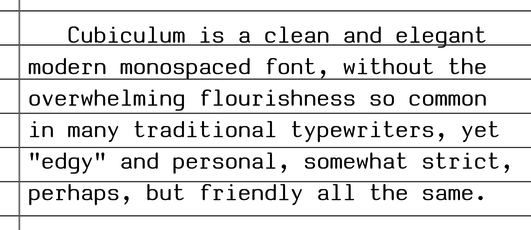 |
| Cubiculum type sample |
As noted in the type specimen above, Cubic manages to be both mechanical in its regularity and adherence to a base-grid and yet friendly because of its squared curves. Its tone is quite unique.
Linotype Egyptienne Bold Condensed
The headings in Warhammer 1st edition and on the character sheets are Egyptienne. These would have been originally set using Letraset rub-down transfers, each individual being rubbed off and so stuck down to a sheet of paper beneath. I'd like to say that I'd followed the same manual process, but I didn't.
 |
| Letraset Egyptiene |
The design itself however weren't created by the Letraset Type Studio, but were based on a 1950s revival of a much earlier typeface. From Fonts in Use:
The precise origin of this design is unclear, but Linotype credits Tetterode, ca. 1820. Tetterode’s successor, Lettergieterij Amsterdam, released Walter H. McKay’s Egyptienne schmalfett and breitfett (Bold Condensed and Extended) in 1955. [Reichardt] This Amsterdam revival was popular in the 1960s–70s and was later digitized by Linotype and others.
The name Egyptienne has nothing to do with the font being particularly Egyptian, but rather stems from the Egyptomania, in the 19th Century when everyone was mad on all things Egyptian, so would have been a fashionable name at the time, bit like how everything got a lowercase 'i' appended to it after the success of the iPhone. Indeed, the whole family of 'slab-serif' typefaces are called Egyptians by the same kind of people who call sans-serif faces Gothic.
And indeed Egyptienne was quite popular in the 70s and 80s.
 |
| 1971 via |
Charles Grant, The War Game uses the Extended (wide) version in both upper and lower-case. Rick Priestly has mentioned Charles Grants Battle in numerous interviews as providing an approach to designing war games which directly influenced the design of Warhammer, (and this is born out by a read of Battle), its interesting that they share the same typographic legacy as well.
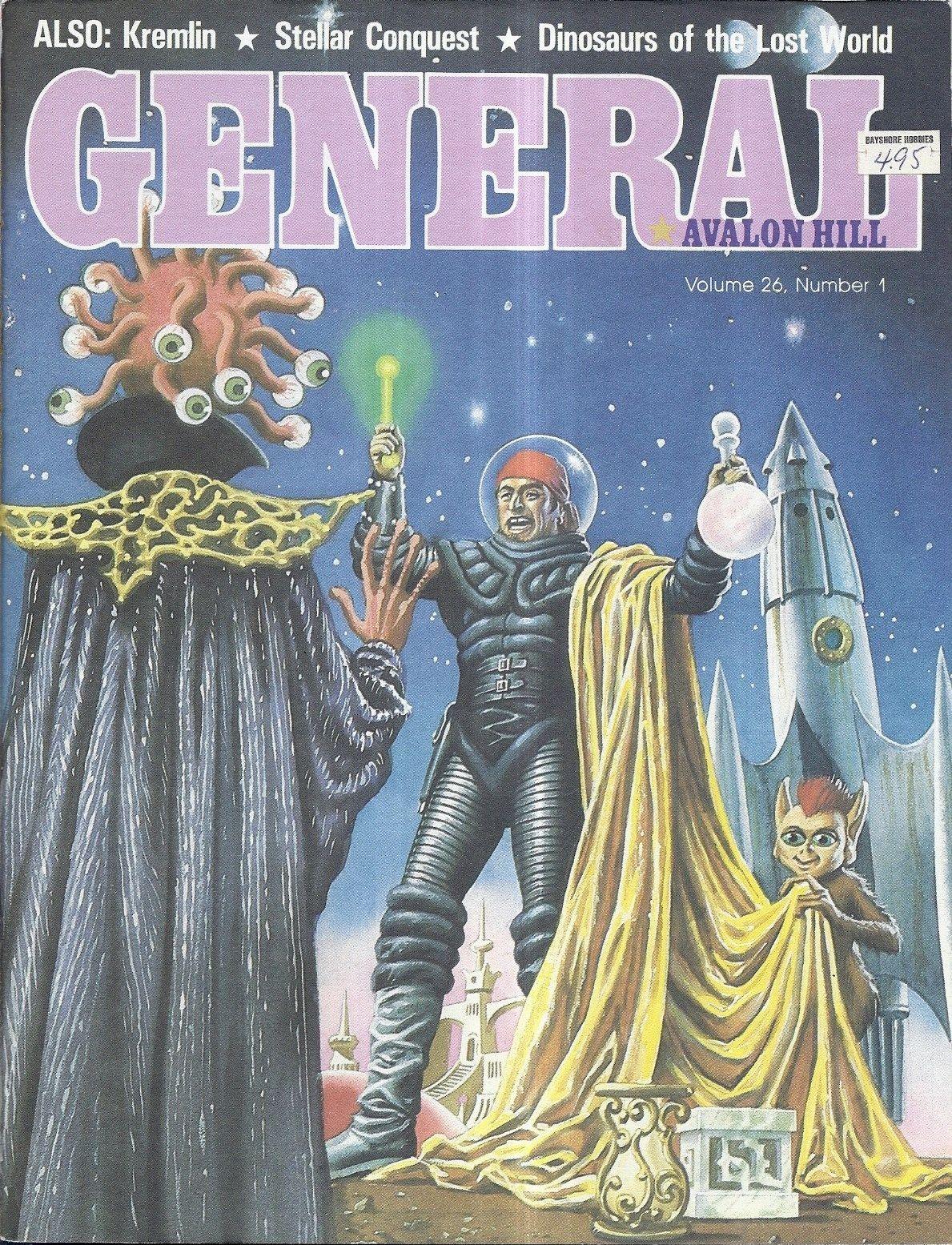 |
| Avalon Hill General |
Egyptienne was also used as the masthead for Avalon Hills General magazine from 1982 until 1993. A wealth of material, archive here. So many PDFs of old school goodness, so little time. Probably most significantly Egyptienne also appears as the main title Games Workshops 1980 edition of Runequest.
No doubt Egyptienne appeared in many other places as well. Although there is a grand tradition of using type based on old wooden letterpress fonts in fantasy gaming (everything from the original Dungeons & Dragons through to The Warlock of Firetop Mountain and beyond) Egyptienne exudes a kind of strudy, Victorian dependability, heavy, slightly oppressive and quite serious. I do wonder if the designers were hoping to conjour something of Egypt, vast ziggurats and cyclopean masonry rather than brick mills and playbills of early industry and reminiscent of other institutions of play.
Anyway, hope you enjoyed the brief history of early Warhmmer typography and get some use from the Character & Regiment Record Sheet!
 |
| GW Runequest | via |
No doubt Egyptienne appeared in many other places as well. Although there is a grand tradition of using type based on old wooden letterpress fonts in fantasy gaming (everything from the original Dungeons & Dragons through to The Warlock of Firetop Mountain and beyond) Egyptienne exudes a kind of strudy, Victorian dependability, heavy, slightly oppressive and quite serious. I do wonder if the designers were hoping to conjour something of Egypt, vast ziggurats and cyclopean masonry rather than brick mills and playbills of early industry and reminiscent of other institutions of play.
Anyway, hope you enjoyed the brief history of early Warhmmer typography and get some use from the Character & Regiment Record Sheet!
Monday 25 September 2017
On Ridgewell
I first encountered the work of John Ridgewell in the 1977 Paper Tiger volume Flights of Icarus, a fantasy art compiled by Roger Dean, where his work appears alongside fantasy art luminaries such as Melvyn Grant, John Blanche and Alan Lee.
| Gate 1976. John Ridgewell |
Although given such high standing company in the illustrative and fantasy art world, one can't help but feel that Ridgewells paintings don't quite belong among the parade of classic prog-rock album, pulp science-fiction covers, poster art, spaceships, dinosaurs and psychedelic horror that the compilation is largely comprised of. Ridgewell is a serious painter, following the surrealism and cubism Georges Braques and René Magritte, but with stylistic nods to Constable or Turner firmly within an English tradition, but also consisting of reflections on painting, genre and art itself .
Parallels could be drawn with Roger Deans or Rodney Matthews landscape work, fantastical spaces that invite the viewer in to meditate upon what forms existence in such a space might take and what states of mind they may provoke, but whereas Dean and Matthews offer the clean, stylised, alien and exotic, Ridgewells landscapes are more familiar, earthy and rustic.
Parallels could be drawn with Roger Deans or Rodney Matthews landscape work, fantastical spaces that invite the viewer in to meditate upon what forms existence in such a space might take and what states of mind they may provoke, but whereas Dean and Matthews offer the clean, stylised, alien and exotic, Ridgewells landscapes are more familiar, earthy and rustic.
| John Ridgewell |
Post-apocalyptic, bombed out and left to seed, destroyed and overgrown, beginning to be reclaimed by nature, landscapes in earthtones, soft grey and somber greens. A small, out of scale picnic robs the ruins of their complete dereliction, but the picnickers are unseen, human scale milkbottles left out on the front-step. One could easily imagine a pair of Froudian imps or gnomes, a hobbit or spriggan encroaching onto the scene and transforming it into a thing of fairytale whimsy, or even a Raymond Briggs character blithely going about their daily business. But the earth stained and rain clad folk that inhabit these lands remain stubbornly out of sight, their absence rejecting a straight picture-book reading.
The crumbling revenants of architecture are not often an ancient Kubla Khan or Ozymanidian temple, no classical ruin of Minerva nor Welsh Gothic of Tintern Abbey beloved by Turner but more often structures of Victorian iron and brickwork, The antique romance of the ruin is then interrupted by a subtle and uncanny modernity - the ghostly clean lines and tidy right angles - interpreted as a white gloss painted door frame that could not possibly have witstood the destruction of the rest of the building, their brittle geometry projecting a wrongness against the mud and mossy brick. In other examples these rectangular forms suggest perhaps a window or picture frame which intrudes into the illusionary space, distorting the sense of scale, shrinking what at first glance may be some far off dilapidated construction to a tiny miniature model on a shelf, or a postcard glued to a wall and overgrown with moss.
These ghostly white structures echo the proportions of the picture frame or visually running parallel, the frames within frames draw attention to the works existence as a work of artifice. This reflexivity is at once an uncomfortable rejection of painting as what could be mistaken for a simple illusionistic, picture-book fantasy as well as a collapse of pictorial space. Instead of the simple reverie of the photograph, the image a substitute for a view of the subject the viewer is invited to contemplate the illusionistic, metaphysical and symbolic nature of the painting, drawing an insistence of considering the image as object in the here and now, the painting interacts within it's famed and hung environment, it's rhetoric spilling out, bringing the frame itself into question, perhaps all we see beyond here is too only a glibly authentic illusion, painstakinlgy constructed by some greater, absent hand. And this seemingly solid illusion, which like the ruined architectural features within the picture, will pass in time.
The crumbling revenants of architecture are not often an ancient Kubla Khan or Ozymanidian temple, no classical ruin of Minerva nor Welsh Gothic of Tintern Abbey beloved by Turner but more often structures of Victorian iron and brickwork, The antique romance of the ruin is then interrupted by a subtle and uncanny modernity - the ghostly clean lines and tidy right angles - interpreted as a white gloss painted door frame that could not possibly have witstood the destruction of the rest of the building, their brittle geometry projecting a wrongness against the mud and mossy brick. In other examples these rectangular forms suggest perhaps a window or picture frame which intrudes into the illusionary space, distorting the sense of scale, shrinking what at first glance may be some far off dilapidated construction to a tiny miniature model on a shelf, or a postcard glued to a wall and overgrown with moss.
These ghostly white structures echo the proportions of the picture frame or visually running parallel, the frames within frames draw attention to the works existence as a work of artifice. This reflexivity is at once an uncomfortable rejection of painting as what could be mistaken for a simple illusionistic, picture-book fantasy as well as a collapse of pictorial space. Instead of the simple reverie of the photograph, the image a substitute for a view of the subject the viewer is invited to contemplate the illusionistic, metaphysical and symbolic nature of the painting, drawing an insistence of considering the image as object in the here and now, the painting interacts within it's famed and hung environment, it's rhetoric spilling out, bringing the frame itself into question, perhaps all we see beyond here is too only a glibly authentic illusion, painstakinlgy constructed by some greater, absent hand. And this seemingly solid illusion, which like the ruined architectural features within the picture, will pass in time.
| Easter painting | John Ridgewell |
Often the locations feel like they could be locations glimpsed out of the corner of the eye in Russell Hobans Riddley Walker (1980). The novels East England is thrown back to a new iron age by a now mythologised and half misunderstood nuclear war. As a post-apocalypse, anachronistic modernisms are interwoven amidst the ruins of more ancient spaces, fractures of culture and language, as Ridgewells visual language, the surreal blending of traditional oil painting genres, the landscape and the still life, while adhering to the formal qualities of genre, are disquietly interrupted by echoes of sraight-line minimalism and modernity.
There we wer then in amongst the broakin stoans the grean rot and the number creaper with the rain all drenching down and peltering on them dead stoans stumps and stannings. Spattering on crumbelt conkreat and bustit birk and durdling in the puddls gurgling down the runnels of the dead town. A kynd of greanish lite to that day from the rain the grean rot and the number creaper and the dead town pong wer going up all grean smelling in that greanish lite. Dog pong as wel a black smel in the grey rain.
Russell Hoban - Riddley Walker
Riddleys language creeps in through the minds ear and performs it's own peculiar magic. Eschewing the naturalism of the novels dull muted language, instead Riddley-speak consists of fractured and ruined archaisms - kynd rubbing shoulders with 20th century slang dog pong. The brutal and disjointed myths constructed out of misunderstandings of and pieced-together historical record. Riddleys language, stories and journey providing holes in time back to the 20th century looking forward into the post-apocalyptic future as well as back into a distant historical past freed from it's linear narrative and erupting like Cornelia Parker's shed, all shrapnel and falling masonry in the ever present now.
 |
| John Ridgewell The Old Wall 1965 via |
 |
| Jimmy Page | Led Zeppelin IV : 1971 |
Tolkien ever one to bemoan reading his Lord of the Rings as being specifically about World War Two or anything else, for that matter, aware nonetheless of the shadow of the conflict, memories of it's fighting and aftermath stretched over the popular reception of his work.
Many of the houses that they had known were missing. Some seemed to have been burned down. The pleasant row of old hobbit-holes in the bank on the north side of the Pool were deserted, and their little gardens that used to run down bright to the water’s edge were rank with weeds. Worse, there was a whole line of the ugly new houses all along Pool Side, where the Hobbiton Road ran close to the bank. An avenue of trees had stood there. They were all gone.If we frame the Scouring of the Shire as a fantastical reimagining of soldiers returning to post-war England, as we can assume many readers in the '50s and '60s readily did, then Ridgwells inclusion in a coffee-table collection of genre led fantasy art such as Flights of Icarus seems more reasonable, if not inevitable, due to shared sensibilities.
Lord of the Rings - Tolkien
| Door | John Ridgewell |
We find another example of the ruin as gateway to the fantastic in post-war imaginary, Alan Gardners Eliador (1965). Here children playing in the derelict streets of Manchester are transported to a solemn mist-shrouded, mythical Narnia, whose sacred artefacts of the Tuatha Dé Danann when lifted out of the dreamscape and placed in the real world become transposed into the most mundane objects imaginable, yet manage to interfere with television transmissions concreting the power of the mythic in the contemporary and domestic.
Roland picked his way over the rubble to the other side of the church door, and there he found a door, which sagged open on broken hinges: two floorboards were nailed across the doorway. Roland climbed into a passage with several rooms leading off it. Water tricked from a fractured pipe. There were the smells of soot and cat.
The rooms were empty except for the things that are always left behind. There were some mouldering Sunday-school registers, a brassbound Bible, a faded sepia photograph of the Whitsun procession of 1909, a copy of Kirktons Standard Temperance Reciter, presented to John Beddowes by the Pendlebury Band of Hope, February 1888. There was a broken saucer. There was a jam-jar furred green with long-dried water.
Eliador - Alan GarnerSetting aside the parallels between Garners ruined church and Hobans cathedral (the grean, the animal smel) Garners catalogue of ephemera could well have composed one of Ridgewells 'portraits', or a page from Salvador Dali's diary, had Salv' been blessed by being born in Salford.
| Tabletop Portrait of Doug Harris |
Portraits, oil painted collections of ephemera, fragments of imagery, tokens of places and locations pulled into the horizon - perhaps a psychogeographical map of the internal life, places lived or loved or a portfolio of property, a painted display of ownership and wealth, as the purpose served by the landscape in oils tradition served, rendered conveniently observable and neatly arranged on a shelf.
Ridgewells tabletop paintings more than any other of his works are a meditation on the blending of oil painting painting genres, the still life and the landscape. presenting a miniature world often contained within a space that appears interior and domestic, the walls becoming ethereal showing the distant landscape beyond, or suggesting a misty mural, b. else seeded spontaneously within the wreckage, creating a contained, fairy tableaux. The play of scale and artefact, a goldfish bowl becomes a monstrously proportioned intrusion, a lace tablecloth a vast and treacherous cliff.
Ridgewells tabletop paintings more than any other of his works are a meditation on the blending of oil painting painting genres, the still life and the landscape. presenting a miniature world often contained within a space that appears interior and domestic, the walls becoming ethereal showing the distant landscape beyond, or suggesting a misty mural, b. else seeded spontaneously within the wreckage, creating a contained, fairy tableaux. The play of scale and artefact, a goldfish bowl becomes a monstrously proportioned intrusion, a lace tablecloth a vast and treacherous cliff.
| Tabletop (in Flights of Icarus ) John Ridgewell |
| Tabletop | John Ridgewell |
Johns string paintings we find the space sealed within itself, a painting of a painting that has been finished and ready to be shipped off, or hidden in storage. The thin ghost-white rectangular forms, interrupting the landscape reappears from other works, but instead of an architectural feature, it binds the painting together as string. Pushing trompe-l'œil to its logical conclusion, the string is not simply painted, as the paper edges are, but physically modelled out of oil paint, built up layer by layer. Is the paper itself decorated, the artist unable to stop himself comulsively turning every surface into a landscape? or is the wrapping becoming transparent betraying the contents underneath, or perhaps the grasses are growing through? The ambiguities that walk through Ridgewells work, seem to have arrived at a destination, painting as subject, themes of rural and rustic, nature reclaiming the man-made, illusionistic and abstract, the inevitability of transience, the dissolution of boundaries, spatial and temporal transportation, something hidden, or missing. A sense of quiet.
Friday 25 August 2017
An Oldhammer Recounting of the Dwarves
It is time for the Dwarfs to get the name-generator treatment. Scouring the full ranges of Citadel Miniature Dwarfs from 1982-1986 to compile a random name generator for dwarf-kind.
The Dwarf name generator is already plugged in to the Oldhammer Scenario Generator on Twitter which has introduced us to the exploits of such hallowed dwarfs as Gorin Dragonhammer and Owd Ketri Stoneaxe, and I also used it to create the name for a D&D character Lard Hookbeard for Bones of the Lost God.
Warhammer Dwarf Name Generator
Or if the trans-dimensional portal iframe above isn't working visit : Ye Olde Oldhammer Dwarf Name Generator It can be a little repetitive, but that's not always a bad thing, as our obligitary journey through the hallowed halls of ancient dwarven kings shall reveal.
The Dwarf Kings Court
Venerable themed box set from 1982, Sculpted by Micheal and Alan Perry. I can't help but imagine this was originally designed as a chess set, with the king and queen, the wizard and jester as bishops, the guards as knights, the bear and blacksmith as rooks, axe-weilder as pawn etc.
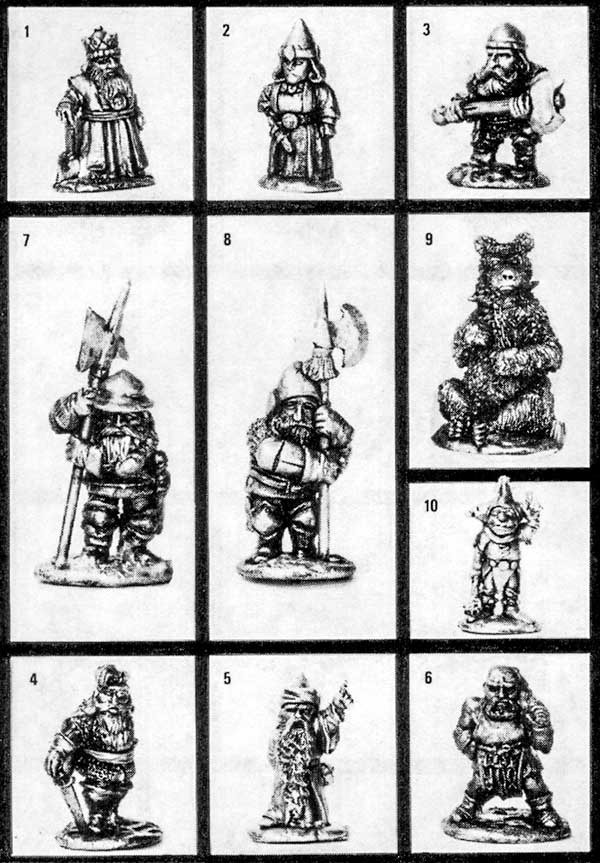 |
| SS2 Dwarf Kings Court |
| SS2 Dwarf Kings Court | King | Dumin | Ironbeard | |
| SS2 Dwarf Kings Court | Queen | Asabelle | Dragonsmiter | |
| SS2 Dwarf Kings Court | Fungil | Wisebeard | The Sage | |
| SS2 Dwarf Kings Court | Quintin | Limpfondle | Queen's Champion | |
| SS2 Dwarf Kings Court | Orizard | Oldrock | ||
| SS2 Dwarf Kings Court | Bomban | Ironbeater | Royal Armourer | |
| SS2 Dwarf Kings Court | Corbit | Shortstuff | ||
| SS2 Dwarf Kings Court | Mimbrin | Royal Guard | ||
| SS2 Dwarf Kings Court | Dimgol | Master of The Guard |
We delve straight into the use of epithetical compound nouns - Wise-beard, Dragon-smiter etc. as we have seen with Orcs, Elves and Chaos Warriors Iron, rock, dwarf characteristic association with mining, and Dragonsmiter highlighting the Dragon as a name-worthy foe - the dwarf/dragon connection runs through the Icelandic Volsunga Saga, Wagner's Sigfried and Tolkien's Hobbit. Other names of interest include:
Corbitt Shortstuff, the Gnome jester not only provided the name, but design for the miniature seems to be based on one half of the comedy duo The Two Ronnies, Ronnie Corbett, who habitually made jokes about his own short stature:- Mimbrin - the dwarf Mim from the Silmarillion.
- Fungil - Fundin from the Dvergertal / Lord of the Rings.
- Bomban - a corruption of Bombur, from the Dvergatal / The Hobbit
- Asabelle - using the French for 'beauty', typical English associations of French with femininity
- Corbitt Shortstuff - reference to comedian Ronnie Corbett
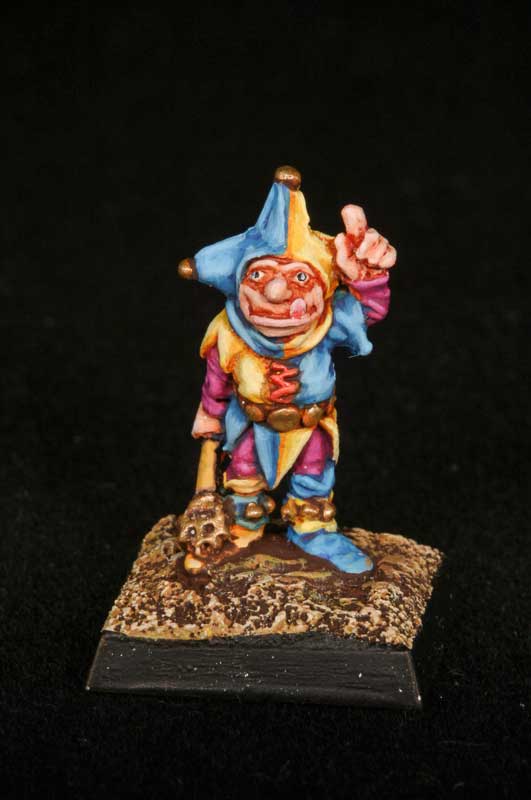 |
| Corbett Shortstuff painted by Steve Mussared via |
 |
| Ronnie Corbett |
I think the bulging eyes on the miniature are supposed to be Ronnies glasses, but I haven't seen the figure in hand, so can't really make a judgement. The poking out tongue is more a Benny Hill than Corbett expression, but a jester named Corbett is a clear homage that would have been easily identifiable in the early 1980s.
Quintin Limpfondle, Queens Champion is sporting the impressively baroque coiffure reminiscent of Quentin Crisp.
If Quintins rather camp tea-pot pose with hand on hip and impressive bouffant do indeed indicate a reference to Quentin Crisp - the title "Queen's Champion" becomes a punning reference to Quentins homosexuality and public championship of gay rights, a literal champion of queens. The surname Limpfondle is perhaps an unpleasant jibe against Quentins effeminate persona, limp-wristed being a once common euphemism for a camp or effeminate homosexual, and fondle being intimate touching. Dwarves, as their mascot Cyril the Bear clearly demonstrates tend to be more rugged, masculine, if somewhat short, Bear types.
1983 two boxed sets of an assortement of adventuring characters of a typical D&D party, featuring three Dwarfs, and the launch of Warhammer saw the of the exclusive, coupon-only Thorgrim Branedimm.
Odan and Olaf, unashamedly Norse in inspiration, Odan perhaps being a corruption of the Norse God Odin, and Olaf being a common old-norse given name. Indirectly we also have Thorgin and the first use of a patronymic '-son' to delinate heritage, adding an ancestral, lineage tradition to Dwarf naming along side the more common compound nouns.
Thorgrim Branedimm, Brain-dim, obviously a stupid fellow. Thor-grim, perhaps related to Thorgin, but similarly evoking the Norse God Thor, and well, being grim. In the grim dwarf history of the ancient gods there is only Thor. Or something. A rare miniature, representing the leader of the dwarfs in the Warhammer 1st Edition Scenario The Ziggurat of Doom and offered as a free figure with proof of purchase. Maybe a reference to Thorgrim from the 1982 swords and sorcery movie Conan the Barbarian.
Drambuin a pun on Drambuie - a whiskey liqure, with a Tolkiensque air - Baranduin being the name of the Hobbitified 'Brandywine' River in the Shire from The Lord of The Rings. It is also, unabashedly Scottish, and I believe, the first Scottish-accented Dwarf reference we have outside of Ronf from Noggin The Nog.
But evidently, this idea of connecting dwarfs with booze caught on around the Citadel Miniatures studios, as the next named release is that all time renowned regiment, Bugmans Dwarf Rangers.
The Dwarven Battlecry of "Mhinz Abeir, Z'yor Rond" ("Mine's a beer, it's your round") cements the regiments place in the annals of Warhammer puns, and underlines the theme of dwarfs as heavy drinkers.
Sculpted by Michael and Alan Perry, the Dwarf Lords of Legend were released in 1985 as a boxed set containing 8 individual characters.
What's strange about Northern Dwarves, is that we already have 'northern' names from Bryan Ansells Heroic Adventurers boxed set - Olaf, and Odan. But rather than continue the nordic theme, the Northern Dwarfs have short, gutteral, and sharp names, perhaps inspired by Tolkiens invented dwarf language Khudzul. If we focus on the examples of Khudzul as they appears in The Lord of the Rings:
And because there is overlap, here's some more...
White Dwarf 80 Imperial Dwarfs
Quintin Limpfondle, Queens Champion is sporting the impressively baroque coiffure reminiscent of Quentin Crisp.
If Quintins rather camp tea-pot pose with hand on hip and impressive bouffant do indeed indicate a reference to Quentin Crisp - the title "Queen's Champion" becomes a punning reference to Quentins homosexuality and public championship of gay rights, a literal champion of queens. The surname Limpfondle is perhaps an unpleasant jibe against Quentins effeminate persona, limp-wristed being a once common euphemism for a camp or effeminate homosexual, and fondle being intimate touching. Dwarves, as their mascot Cyril the Bear clearly demonstrates tend to be more rugged, masculine, if somewhat short, Bear types.
The Dwarf Adventurers
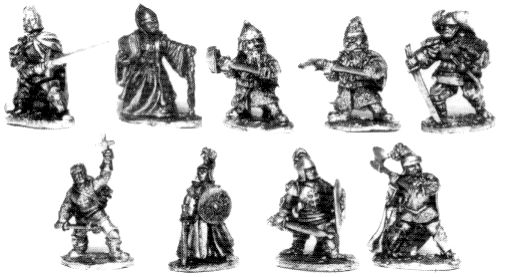 |
| Bryan Ansells Heroic Adventurers |
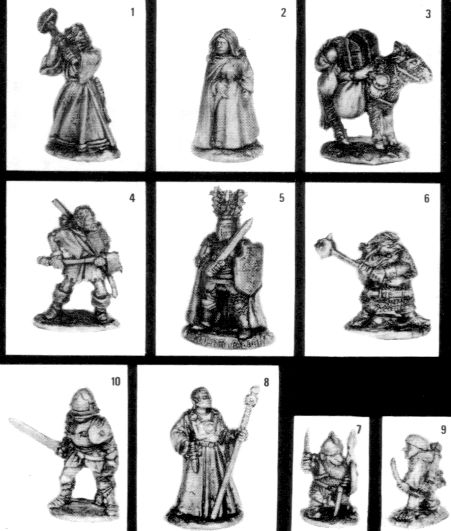 |
| Dungeon Adventurers Starter set |
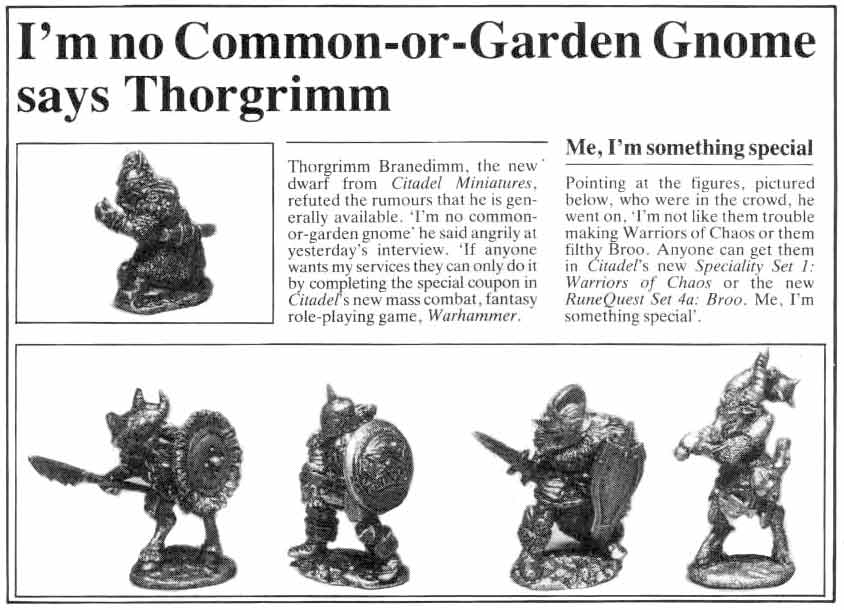 |
| Thorgrimm Branedim from White Dwarf |
1983 two boxed sets of an assortement of adventuring characters of a typical D&D party, featuring three Dwarfs, and the launch of Warhammer saw the of the exclusive, coupon-only Thorgrim Branedimm.
| Bryan Ansell's Heroic Adventurers | Odan | Grimbeard | ||
| Bryan Ansell's Heroic Adventurers | Olaf | Thorginson | ||
| Dungeon Adventurers Starter Set - Version 2 | Drambuin | The Dwarf |
Odan and Olaf, unashamedly Norse in inspiration, Odan perhaps being a corruption of the Norse God Odin, and Olaf being a common old-norse given name. Indirectly we also have Thorgin and the first use of a patronymic '-son' to delinate heritage, adding an ancestral, lineage tradition to Dwarf naming along side the more common compound nouns.
Thorgrim Branedimm, Brain-dim, obviously a stupid fellow. Thor-grim, perhaps related to Thorgin, but similarly evoking the Norse God Thor, and well, being grim. In the grim dwarf history of the ancient gods there is only Thor. Or something. A rare miniature, representing the leader of the dwarfs in the Warhammer 1st Edition Scenario The Ziggurat of Doom and offered as a free figure with proof of purchase. Maybe a reference to Thorgrim from the 1982 swords and sorcery movie Conan the Barbarian.
 |
| Thorgrim vs. Conan |
Drambuin a pun on Drambuie - a whiskey liqure, with a Tolkiensque air - Baranduin being the name of the Hobbitified 'Brandywine' River in the Shire from The Lord of The Rings. It is also, unabashedly Scottish, and I believe, the first Scottish-accented Dwarf reference we have outside of Ronf from Noggin The Nog.
 |
| Vintage 1970s bottle of Dwarf Liquor |
But evidently, this idea of connecting dwarfs with booze caught on around the Citadel Miniatures studios, as the next named release is that all time renowned regiment, Bugmans Dwarf Rangers.
| RR1 Bugmans Dwarf Rangers | Joseph | Bugman | |
| RR1 Bugmans Dwarf Rangers | Jeorj | Ruddle | |
| RR1 Bugmans Dwarf Rangers (1986 re-release) | Owd | Tom | Thyksson |
The Dwarven Battlecry of "Mhinz Abeir, Z'yor Rond" ("Mine's a beer, it's your round") cements the regiments place in the annals of Warhammer puns, and underlines the theme of dwarfs as heavy drinkers.
- Jeorj Ruddle is a reference to George Ruddle, the founder of Ruddles Brewery, now a brand name of Green King, with neither the recipies or brewery location having any connection to the original.
- Tom Thyksson appears to be a reference to Theakstons brewery, and particually the 'Owd' being their legendary brew Old Peculiar.
- Joseph Bugman appears to be an original invention, who continues today with the beers sold in Warhammer World Dwarf themed ales from Nottingham Brewery
Perhaps significantly Joseph and Tom are not fantasy misspellings like Jeorj or loosely based on Norse myth or it's Tolkien derivatives but just common English names. The case for dwarfs adopting common names from human cultures is made by Tolkien, whose dwarfs have their own 'secret' names in the dwarf language Khudzul, but for day-to-day purposes use a human name, although Tolkiens human-language names are Old Norse, rather than English. More on that later...
The Dwarf Lords of Legend
Sculpted by Michael and Alan Perry, the Dwarf Lords of Legend were released in 1985 as a boxed set containing 8 individual characters.
 |
| Dwarf Lords of Legend Box Art | John Blanche |
| BC3 Dwarf Lords of Legend | Borax | Bloodaxe | ||
| BC3 Dwarf Lords of Legend | Angus | |||
| BC3 Dwarf Lords of Legend | Throbin | Death Eye | ||
| BC3 Dwarf Lords of Legend | Kimril | Giantslayer | ||
| BC3 Dwarf Lords of Legend | Lastro | Lupintal | ||
| BC3 Dwarf Lords of Legend | King | Gorin | ||
| BC3 Dwarf Lords of Legend | The Baron | |||
| BC3 Dwarf Lords of Legend | Uther |
- Borax is a chemical cleaner.
- Angus, a stereotypically Scottish name.
- Throbin, a pun on thobbing, with slight reference to Thorin from Dvergertal/Hobbit
- Lupintal - Lupin Tall - tall as a lupin?
- Uther - Uther Pendragon, legendary King and father of King Arthur.
C06 Northern Dwarfs
| C06 Northern Dwarfs | Bal | Irut | |
| C06 Northern Dwarfs | Lun | Zud | |
| C06 Northern Dwarfs | Luk | Aruk | |
| C06 Northern Dwarfs | Khul | Dun | |
| C06 Northern Dwarfs | Oran | Aruk | |
| C06 Northern Dwarfs | Carluk | Aton | |
| C06 Northern Dwarfs | Anuk | Ilrut | |
| C06 Northern Dwarfs | Nazcar | Aruz | |
| C06 Northern Dwarfs | Org | Kiluk | |
| C06 Northern Dwarfs | Hith-amata | ||
| C06 Northern Dwarfs | No-car | Emol | |
| C06 Northern Dwarfs | Luk-a-car | Mut | |
| C06 Northern Dwarfs | Oran-ilrut |
Several of the Northern Dwarf names appear to be car puns, Luk-a-car Look a Car? Nazcar? Oran Aruk Or Anorak?
- Baruk Khazâd! Khazâd ai-mênu!
- Balin Fundinul uzbad Khazad-dûmu
- Azanulbizar
- Kheled-zâram
- Mazarbul
- Barazinbar
- Bundushathur
- Kibil-nâla
- Tharkûn (Gandalf)
- Zirak-zigil
Whilst by no means a reconstructive extension of Tolkiens constructed language, there are features in the Citadel Northern Dwarf that are familiar: the use of hyphenations, frequent uses of 'z' and 'kh' 'uk', 'bal', Thematically Tolkien has Khudzul as a secret language, and that Dwarves commonly take on names from their surrounding cultures, so would typically choose a 'human' name for use outside the secret halls of dwarfdom. As such these names don't appear in the generator, which only produces outward facing names.
C06 Imperial Dwarfs
The Imperial Dwarves, as opposed to the Norse Dwarfs and the Chaos Dwarfs (who deserve a separate enquiry altogether), again sculpted by Micheal and Alan Perry, released in 1986.
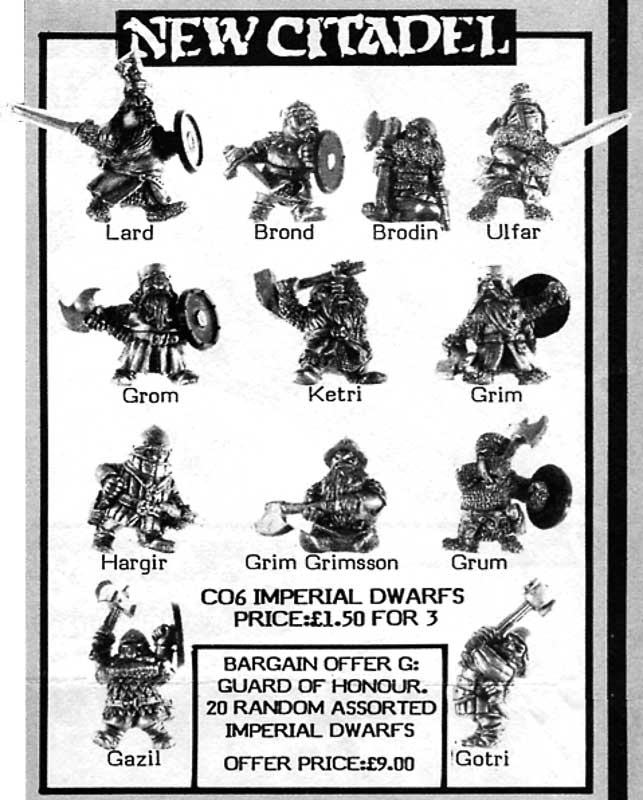 |
| August 1986 Flyer |
| C06 Imperial Dwarves | Lard | ||
| C06 Imperial Dwarves | Brond | ||
| C06 Imperial Dwarves | Brodin | ||
| C06 Imperial Dwarves | Ulfar | ||
| C06 Imperial Dwarves | Grom | ||
| C06 Imperial Dwarves | Ketri | ||
| C06 Imperial Dwarves | Grim | ||
| C06 Imperial Dwarves | Hargir | ||
| C06 Imperial Dwarves | Grim | Grimson | |
| C06 Imperial Dwarves | Grum | ||
| C06 Imperial Dwarves | Gazil | ||
| C06 Imperial Dwarves | Gotri |
And because there is overlap, here's some more...
White Dwarf 80 Imperial Dwarfs
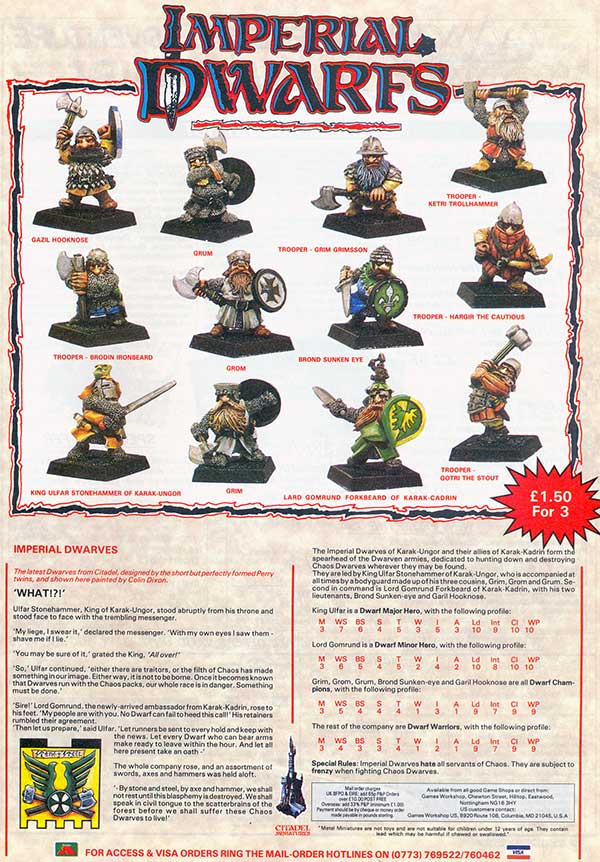 |
| Imperial Dwarfs | White Dwarf 80 |
| Imperial Dwarfs | Gazil | Hooknose | ||
| Imperial Dwarfs | Grum | |||
| Imperial Dwarfs | Trooper | Grim | Grimson | |
| Imperial Dwarfs | Trooper | Ketri | Trollhammer | |
| Imperial Dwarfs | Trooper | Bromi | Iornbeard | |
| Imperial Dwarfs | Grom | |||
| Imperial Dwarfs | Brond | Sunkeneye | ||
| Imperial Dwarfs | Trooper | Hargir | The Cautious | |
| Imperial Dwarfs | King | Ulfar | Stonehammer | of Karak Ungor |
| Imperial Dwarfs | Grim | |||
| Imperial Dwarfs | Lard | Gormund | of Karak Kadrin | |
| Imperial Dwarfs | Trooper | Gotri | The Stout |
Again we have the epithetical compound nouns, Stone-hammer, Hook-nose, and the appearance of Troll as a name-worthy enemy.
Lard Gormund is notable as Lard, rendered pig fat, and Gormund, like Gourmand, a glutton.
We also have Grim Grimson, who we may safely assume is son of Grim, building the familial relationship between the characters, helping establish the sense of dwarven clannishness.
There is also the first apearance of tying the name to specific place. Karak Ungor and Karak Kadrin. Which with the proponderance of K's seems vaguely deriviative of Tolkiens Khudzul .The Karaks as names of dwarven strongholds go back to the first edition of Warhammer Fatnasy Battle, with Caraz-A-Carak (Car has a car rack?). Seems a bit of a asted opportunity not to keep throwing puns in there, Karak-Akan, Karak-Agax or Karak-Edz. Karaz-A-Rufrak.
With, Grim, Grom, Grum, Gotri, Ketri there is an alliterative naming convention that we see in Tolkiens Hobbit, which stems from the Dvergatal in the Völuspá, a poem that catalogues and names the Dwarfs.
Dvergatal, or "The Recounting of the Dwarves".
There was Motsognir the mightiest made
Of all the dwarfs, and Durin next;
Many a likeness of men they made,
The dwarfs in the earth, as Durin said.
Nyi and Nithi, Northri and Suthri,
Austri and Vestri, Althjof, Dvalin,
Nar and Nain, Niping, Dain,
Bifur, Bofur, Bombur, Nori,
An and Onar, Ai, Mjothvitnir.
Vigg and Gandalf, Vindalf, Thrain,
Thekk and Thorin, Thror, Vit and Lit,
Nyr and Nyrath, now have I told
Regin and Rathsvith the list aright.
Fili, Kili, Fundin, Nali,
Hepti, Vili, Hannar, Sviur,
Billing, Bruni, Bildr and Buri,
Frar, Hornbori, Fræg and Loni,
Aurvang, Jari, Eikinskjaldi.
The race of the dwarfs in Dvalin's throng
Down to Lofar the list must I tell;
The rocks they left, and through wet lands
They sought a home in the fields of sand.
There were Draupnir and Dolgthrasir,
Hor, Haugspori, Hlevang, Gloin,
Dori, Ori, Duf, Andvari,
Skirfir, Virfir, Skafith, Ai.
Alf and Yngvi, Eikinskjaldi,
Fjalar and Frosti, Finn and Ginnar;
So for all time shall the tale be known,
The list of all the forbears of Lofar.
The list of Dwarf names was used by Tolkien in The Hobbit, and indeed John Rateliff in The History of the Hobbit speculates, with good textural reasoning, that one of the chief inspirations for the story was Tolkien working out why an Elf - Gandalf, that is a "Wand-elf" is travelling with all these dvergr.
Another of Tolkiens creative interpretations was to make the similar sounding names indicate familial relations. So, for example Oin and Gloin became brothers, and this idea of a familial structure being important to Dwarfs surfaces with Grim Grimson and the next wave of dwarf.
RR6 Prince Ulthers Dragon Company
 |
| Prince Ulther's Imperial Dwarfs |
| King | Ulther | son of Ulfar of Karak-Ungor | |
| Borri | Forkbeard |
Both Ulther and Borri, have a traditional Northern feel, Ulther via Uther Pendragon, and Borri not being far removed from the Ori, Norri and Dori of the Dvergertal.
King Ulther, son of Ulfar - Ulfar is in fact one of the Imperial Dwarfs listed in White Dwarf 80 so we have the theme of familial lineage developing, again establishing the clannishness of the Dwarf ranges, and indicating a level of world-building and story-telling not seen before. The self-referntial also helps make sense of a rather repetitive name generator, as repeating surnames indicate the characters belong to the same clan or extended family.
D4 Dwarf Adventurers
With the publication of Warhammer Fantasy Roleplay in 1986, there is a brief return to the theme of adventurers, again sculpted by the Perry Twins.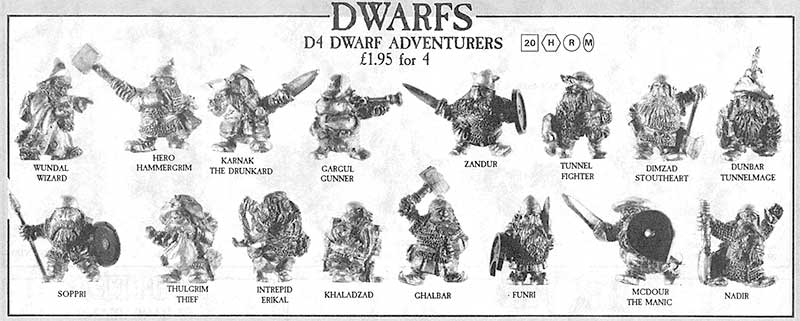 |
| 1987 Flyer |
 |
| Citadel Journal Spring 87 |
| D4 Dwarf Adventurers | Wundal | Wizard | ||
| D4 Dwarf Adventurers | Hero | Hammergrim | ||
| D4 Dwarf Adventurers | Kanark | The Drunkard | ||
| D4 Dwarf Adventurers | Gargul | The Gunner | ||
| D4 Dwarf Adventurers | Zandur | |||
| D4 Dwarf Adventurers | Dimzad | Stoutheart | ||
| D4 Dwarf Adventurers | Dunbar | Tunnelmage | ||
| D4 Dwarf Adventurers | Soppri | |||
| D4 Dwarf Adventurers | Thulgrim | The Thief | ||
| D4 Dwarf Adventurers | Intrepid | Erikal | ||
| D4 Dwarf Adventurers | Khaladzad | |||
| D4 Dwarf Adventurers | Ghalbar | |||
| D4 Dwarf Adventurers | Funri | |||
| D4 Dwarf Adventurers | McDour | The Manic | ||
| D4 Dwarf Adventurers | Nadir |
More loosely inspired by the Hobbit and the Dvergrtal, with slight nods to Tolkiens Dwarven language of Khudzul appearing with Khaladzad. Nadir, being a low-point is maybe a joke on the dwarfs low stature, and Karnark the Drunkard reminding what the Alcoholism rules in Warhammer are there to be used.
White Dwarf 95 Dwarf Adventurers
Yet more dwarf adventurers appear in White Dwarf 95.| D4 Dwarf Adventurers | Adumm | ||
| D4 Dwarf Adventurers | Little | Andii | |
| D4 Dwarf Adventurers | Arnuld | ||
| D4 Dwarf Adventurers | Aydriun | ||
| D4 Dwarf Adventurers | Balcony | Kryss | |
| D4 Dwarf Adventurers | Eyunna | Lexanda | |
| D4 Dwarf Adventurers | Fhyll | Madaxe | |
| D4 Dwarf Adventurers | Halfdan | ||
| D4 Dwarf Adventurers |
Hassan I Sahbha
| ||
| D4 Dwarf Adventurers | Khrys | Rabinsson | |
| D4 Dwarf Adventurers | Klann | Danelaw | |
| D4 Dwarf Adventurers | Iron | Mhyke | |
| D4 Dwarf Adventurers | Wild | Nyjhul | |
| D4 Dwarf Adventurers | Ogg | ||
| D4 Dwarf Adventurers | Palldee | ||
| D4 Dwarf Adventurers | Old | Peet | |
| D4 Dwarf Adventurers | Prang | ||
| D4 Dwarf Adventurers | Rashasawa | ||
| D4 Dwarf Adventurers | Raven | ||
| D4 Dwarf Adventurers | Rhobb | Grimly | |
| D4 Dwarf Adventurers | Shaz | Ensun | |
| D4 Dwarf Adventurers | Shrubs | ||
| D4 Dwarf Adventurers | Skargell | ||
| D4 Dwarf Adventurers | Slymm | ||
| D4 Dwarf Adventurers | Spudd | ||
| D4 Dwarf Adventurers | Tynsul | Tymm | |
| D4 Dwarf Adventurers | Writch | ||
| D4 Dwarf Adventurers | Yak |
These are a strange list, quite out of keeping with the last run. After establishing the 'fantasy' feel for Dwarf names, blending Tolkien and norse myth, these are little more than funny spellings of common English forenames, Khrys for Chris, Nyjhul for Nigel, Peet for Pete etc. It's entirely possible these are references to real people, perhaps gamers or Games Workshop staff, but without knowing the targets of any particular jest, it's difficult to know if we've come full circle to the Quintins and Corbetts of the Dwarf Kings Court, or are just scraping the bottom of the barrel of faux-English names.
There are a few names that manage to stand out:
- Khrys Robinson - Christopher Robin - owner of Pooh and son of A. A. Milne.
- Iron Mike - reference to boxer 'Iron' Mike Tyson.
- Skargell - reference to Arthur Scargill and the miniature is a miner. Been there before!
- Hassan I Sahbha - obviously an Assasin pun, also a Hawkwind song.
- Rashasawa - a portmanteau reference to Akira Kurosawa's Rashomon ?
- Ogg - a reference to the dwarf Og in the Time Bandits
OK. Can I go back to calling them Dwarves now? Tolkien was right, it's more natural than Dwarfs.
Subscribe to:
Posts (Atom)
